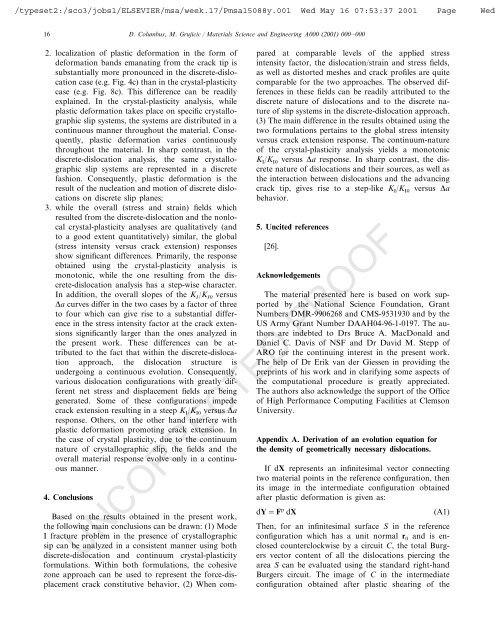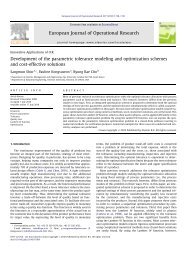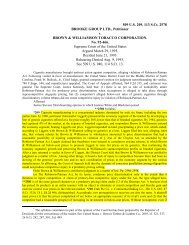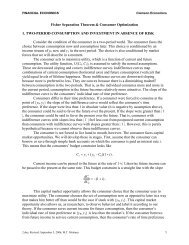A comparative discrete-dislocation/nonlocal crystal-plasticity
A comparative discrete-dislocation/nonlocal crystal-plasticity
A comparative discrete-dislocation/nonlocal crystal-plasticity
Create successful ePaper yourself
Turn your PDF publications into a flip-book with our unique Google optimized e-Paper software.
typeset2:/sco3/jobs1/ELSEVIER/msa/week.17/Pmsa15088y.001 Wed May 16 07:53:37 2001 Page Wed<br />
16<br />
D. Columbus, M. Grujicic / Materials Science and Engineering A000 (2001) 000–000<br />
2. localization of plastic deformation in the form of<br />
deformation bands emanating from the crack tip is<br />
substantially more pronounced in the <strong>discrete</strong>-<strong>dislocation</strong><br />
case (e.g. Fig. 4c) than in the <strong>crystal</strong>-<strong>plasticity</strong><br />
case (e.g. Fig. 8c). This difference can be readily<br />
explained. In the <strong>crystal</strong>-<strong>plasticity</strong> analysis, while<br />
plastic deformation takes place on specific <strong>crystal</strong>lographic<br />
slip systems, the systems are distributed in a<br />
continuous manner throughout the material. Consequently,<br />
plastic deformation varies continuously<br />
throughout the material. In sharp contrast, in the<br />
<strong>discrete</strong>-<strong>dislocation</strong> analysis, the same <strong>crystal</strong>lographic<br />
slip systems are represented in a <strong>discrete</strong><br />
fashion. Consequently, plastic deformation is the<br />
result of the nucleation and motion of <strong>discrete</strong> <strong>dislocation</strong>s<br />
on <strong>discrete</strong> slip planes;<br />
3. while the overall (stress and strain) fields which<br />
resulted from the <strong>discrete</strong>-<strong>dislocation</strong> and the <strong>nonlocal</strong><br />
<strong>crystal</strong>-<strong>plasticity</strong> analyses are qualitatively (and<br />
to a good extent quantitatively) similar, the global<br />
(stress intensity versus crack extension) responses<br />
show significant differences. Primarily, the response<br />
obtained using the <strong>crystal</strong>-<strong>plasticity</strong> analysis is<br />
monotonic, while the one resulting from the <strong>discrete</strong>-<strong>dislocation</strong><br />
analysis has a step-wise character.<br />
In addition, the overall slopes of the K I/K I0 versus<br />
a curves differ in the two cases by a factor of three<br />
to four which can give rise to a substantial difference<br />
in the stress intensity factor at the crack extensions<br />
significantly larger than the ones analyzed in<br />
the present work. These differences can be attributed<br />
to the fact that within the <strong>discrete</strong>-<strong>dislocation</strong><br />
approach, the <strong>dislocation</strong> structure is<br />
undergoing a continuous evolution. Consequently,<br />
various <strong>dislocation</strong> configurations with greatly different<br />
net stress and displacement fields are being<br />
generated. Some of these configurations impede<br />
crack extension resulting in a steep K I/K I0 versus a<br />
response. Others, on the other hand interfere with<br />
plastic deformation promoting crack extension. In<br />
the case of <strong>crystal</strong> <strong>plasticity</strong>, due to the continuum<br />
nature of <strong>crystal</strong>lographic slip, the fields and the<br />
overall material response evolve only in a continuous<br />
manner.<br />
4. Conclusions<br />
Based on the results obtained in the present work,<br />
the following main conclusions can be drawn: (1) Mode<br />
I fracture problem in the presence of <strong>crystal</strong>lographic<br />
sip can be analyzed in a consistent manner using both<br />
UNCORRECTED PROOF<br />
<strong>discrete</strong>-<strong>dislocation</strong> and continuum <strong>crystal</strong>-<strong>plasticity</strong><br />
formulations. Within both formulations, the cohesive<br />
zone approach can be used to represent the force-displacement<br />
crack constitutive behavior. (2) When com-<br />
pared at comparable levels of the applied stress<br />
intensity factor, the <strong>dislocation</strong>/strain and stress fields,<br />
as well as distorted meshes and crack profiles are quite<br />
comparable for the two approaches. The observed differences<br />
in these fields can be readily attributed to the<br />
<strong>discrete</strong> nature of <strong>dislocation</strong>s and to the <strong>discrete</strong> nature<br />
of slip systems in the <strong>discrete</strong>-<strong>dislocation</strong> approach.<br />
(3) The main difference in the results obtained using the<br />
two formulations pertains to the global stress intensity<br />
versus crack extension response. The continuum-nature<br />
of the <strong>crystal</strong>-<strong>plasticity</strong> analysis yields a monotonic<br />
K I/K I0 versus a response. In sharp contrast, the <strong>discrete</strong><br />
nature of <strong>dislocation</strong>s and their sources, as well as<br />
the interaction between <strong>dislocation</strong>s and the advancing<br />
crack tip, gives rise to a step-like K I/K I0 versus a<br />
behavior.<br />
5. Uncited references<br />
[26].<br />
Acknowledgements<br />
The material presented here is based on work supported<br />
by the National Science Foundation, Grant<br />
Numbers DMR-9906268 and CMS-9531930 and by the<br />
US Army Grant Number DAAH04-96-1-0197. The authors<br />
are indebted to Drs Bruce A. MacDonald and<br />
Daniel C. Davis of NSF and Dr David M. Stepp of<br />
ARO for the continuing interest in the present work.<br />
The help of Dr Erik van der Giessen in providing the<br />
preprints of his work and in clarifying some aspects of<br />
the computational procedure is greatly appreciated.<br />
The authors also acknowledge the support of the Office<br />
of High Performance Computing Facilities at Clemson<br />
University.<br />
Appendix A. Derivation of an evolution equation for<br />
the density of geometrically necessary <strong>dislocation</strong>s.<br />
If dX represents an infinitesimal vector connecting<br />
two material points in the reference configuration, then<br />
its image in the intermediate configuration obtained<br />
after plastic deformation is given as:<br />
dY=F p dX (A1)<br />
Then, for an infinitesimal surface S in the reference<br />
configuration which has a unit normal r 0 and is enclosed<br />
counterclockwise by a circuit C, the total Burgers<br />
vector content of all the <strong>dislocation</strong>s piercing the<br />
area S can be evaluated using the standard right-hand<br />
Burgers circuit. The image of C in the intermediate<br />
configuration obtained after plastic shearing of the
















